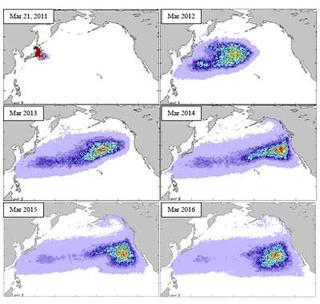Japanese Debris Popping Up on Unalaska Beaches

Wednesday, May 30 2012
Over a million tons of Japanese tsunami debris is still floating on the ocean's surface, and a good bit of it is expected to hit North America’s shores over the next few years. Things like sporting goods, fishing gear, and even a motorcycle have already been spotted.
In Unalaska, bottles and household cleaning items with Japanese text on them have started popping up on the beaches, serving as a reminder of the disaster's scope and also creating an odd sort of scavenger hunt. Resident Nick Butryn stumbled across one item that might have come from the tsunami when he was beachcombing in April.
“I was walking in front of where the Safeway is, and I had seen this red jug,” says Butryn. “I just thought it was a typical red jug, but when I kicked it over I saw Asian writing on it.“
Butryn immediately reported the find to the Marine Conservation Alliance Foundation, a non-profit group that has set up a debris-monitoring program. They couldn’t definitively tell him whether the jug was carried away by last year’s tsunami, but they did suggested it was a possibility since the jug was light and capable of being pushed along by the wind.
Dave Gaudet is the coordinator of the monitoring program, and he says that he was initially surprised to see debris arrive on Alaska’s shores so early. The debris wasn’t supposed to make landfall until the end of the year according to current projections, but strong winds seem to have pushed light objects like buoys and Styrofoam across the ocean at faster rates than expected. Gaudet says that the interplay between wind and current action should cause the debris to come in stages.
“We believe there are going to be more waves,” says Gaudet. The next wave is probably going to be something that’s affected just by wind as it is the current, and then maybe there will be another wave of things that are negatively buoyant that are affected completely by the current.”
Gaudet adds that it’s often tricky to identify with any marine debris with any certainty, since Japanese flotsam was often found in Alaska even before the tsunami. The monitoring program employs four contractors who are familiar with Alaska beaches and who can pick out unusual items from the standard Japanese fare that washes up in the state. The contractors also keep track of how much Japanese stuff they find on the beaches and how that compares historically. They’re especially mindful of toxic materials or anything that can harm wildlife. Nets and old fishing line can create hazards to marine life, and Styrofoam and stores of kerosene can be toxic to anything that ingests them.
Not all of the debris is harmful, though, and some of it might even be treasured.
“We have heard rumors that there were areas [of coastal Japan] where glass balls were stored,” says Gaudet. “They were probably picked up by the tsunami and may be out on the ocean again.”
Nick Butryn says that he’ll definitely be out looking for those glass floats. He moved to Unalaska last year, and has yet to find one. He’ll be beachcombing for other things, too, since he likes to repurpose found objects and repurpose them into art or useful goods.
Butryn says that some people have advised him against it, though, out of worry that the tsunami wreckage might be radioactive. He doesn’t share their concern.
“I grew up in New Jersey. I’ve seen more than one hypodermic needle on the beach,” says Butryn.
The monitoring program contractors have been testing debris with Geiger counters, and they haven’t come across any radioactive materials so far. Butryn jokes that if beachcombing does expose him to radioactivity, he hopes that it will at least give him a good superhero origin story.
“The superpower will be for me to locate glass balls in record numbers,” says Butryn.
You can report any possible tsunami debris to the Marine Conservation Alliance Foundation by e-mailing marinedebris@ak.net or posting a photograph to the SeaAlliance Facebook page.




Tom Gemmell on Thursday, May 31 2012:
Join this Facebook group to share info on marine debris in Alaska:
https://www.facebook.com/groups/140608506054408/